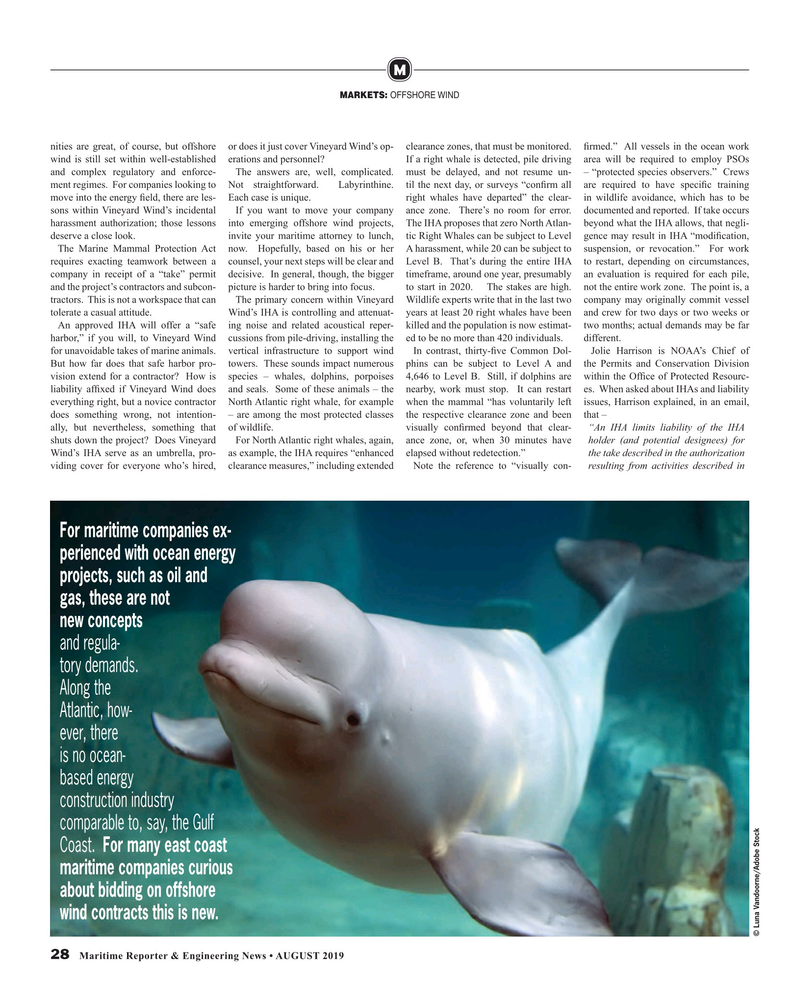
Page 28: of Maritime Reporter Magazine (August 2019)
The Shipyard Edition
Read this page in Pdf, Flash or Html5 edition of August 2019 Maritime Reporter Magazine
M
MARKETS: OFFSHORE WIND nities are great, of course, but offshore or does it just cover Vineyard Wind’s op- clearance zones, that must be monitored. ? rmed.” All vessels in the ocean work wind is still set within well-established erations and personnel? If a right whale is detected, pile driving area will be required to employ PSOs and complex regulatory and enforce- The answers are, well, complicated. must be delayed, and not resume un- – “protected species observers.” Crews ment regimes. For companies looking to Not straightforward. Labyrinthine. til the next day, or surveys “con? rm all are required to have speci? c training move into the energy ? eld, there are les- Each case is unique. right whales have departed” the clear- in wildlife avoidance, which has to be sons within Vineyard Wind’s incidental If you want to move your company ance zone. There’s no room for error. documented and reported. If take occurs harassment authorization; those lessons into emerging offshore wind projects, The IHA proposes that zero North Atlan- beyond what the IHA allows, that negli- deserve a close look. invite your maritime attorney to lunch, tic Right Whales can be subject to Level gence may result in IHA “modi? cation,
The Marine Mammal Protection Act now. Hopefully, based on his or her A harassment, while 20 can be subject to suspension, or revocation.” For work requires exacting teamwork between a counsel, your next steps will be clear and Level B. That’s during the entire IHA to restart, depending on circumstances, company in receipt of a “take” permit decisive. In general, though, the bigger timeframe, around one year, presumably an evaluation is required for each pile, and the project’s contractors and subcon- picture is harder to bring into focus. to start in 2020. The stakes are high. not the entire work zone. The point is, a tractors. This is not a workspace that can The primary concern within Vineyard Wildlife experts write that in the last two company may originally commit vessel tolerate a casual attitude. Wind’s IHA is controlling and attenuat- years at least 20 right whales have been and crew for two days or two weeks or
An approved IHA will offer a “safe ing noise and related acoustical reper- killed and the population is now estimat- two months; actual demands may be far harbor,” if you will, to Vineyard Wind cussions from pile-driving, installing the ed to be no more than 420 individuals. different.
for unavoidable takes of marine animals. vertical infrastructure to support wind In contrast, thirty-? ve Common Dol- Jolie Harrison is NOAA’s Chief of
But how far does that safe harbor pro- towers. These sounds impact numerous phins can be subject to Level A and the Permits and Conservation Division vision extend for a contractor? How is species – whales, dolphins, porpoises 4,646 to Level B. Still, if dolphins are within the Of? ce of Protected Resourc- liability af? xed if Vineyard Wind does and seals. Some of these animals – the nearby, work must stop. It can restart es. When asked about IHAs and liability everything right, but a novice contractor North Atlantic right whale, for example when the mammal “has voluntarily left issues, Harrison explained, in an email, does something wrong, not intention- – are among the most protected classes the respective clearance zone and been that – ally, but nevertheless, something that of wildlife. visually con? rmed beyond that clear- “An IHA limits liability of the IHA shuts down the project? Does Vineyard For North Atlantic right whales, again, ance zone, or, when 30 minutes have holder (and potential designees) for
Wind’s IHA serve as an umbrella, pro- as example, the IHA requires “enhanced elapsed without redetection.” the take described in the authorization viding cover for everyone who’s hired, clearance measures,” including extended Note the reference to “visually con- resulting from activities described in
For maritime companies ex- perienced with ocean energy projects, such as oil and gas, these are not new concepts and regula- tory demands.
Along the
Atlantic, how- ever, there is no ocean- based energy construction industry comparable to, say, the Gulf
Coast. For many east coast maritime companies curious about bidding on offshore wind contracts this is new. © Luna Vandoorne/Adobe Stock 28 Maritime Reporter & Engineering News • AUGUST 2019
MR #8 (26-33).indd 28 8/7/2019 9:17:42 AM

 27
27

 29
29
